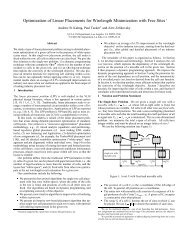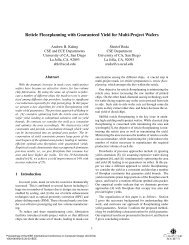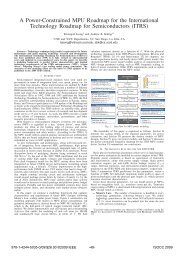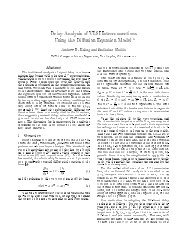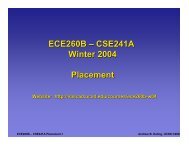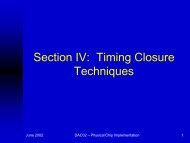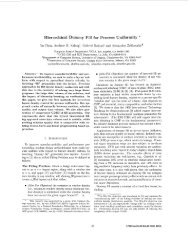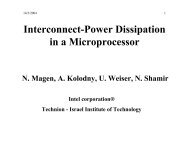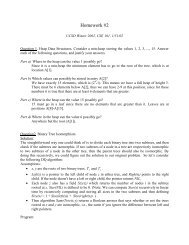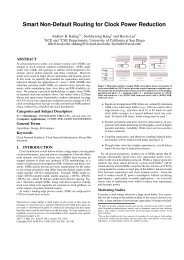Fast and efficient phase conflict detection and correction in standard ...
Fast and efficient phase conflict detection and correction in standard ...
Fast and efficient phase conflict detection and correction in standard ...
Create successful ePaper yourself
Turn your PDF publications into a flip-book with our unique Google optimized e-Paper software.
. Hence, start<strong>in</strong>g from Ò ½, the node <strong>phase</strong>s will flip an odd number oftimes <strong>in</strong> . Therefore, the node Ò ½ will be assigned two different <strong>phase</strong>s,which is impossible. Hence our assumption that , whose correspond<strong>in</strong>glayout Ä is <strong>phase</strong>-assignable, has a <strong>conflict</strong> cycle is wrong.()Assume does not conta<strong>in</strong> any <strong>conflict</strong> cycles. WLOG, assume is connected (if is not connected, the proof can be done for each of connectedcomponents of ). Assume further that Ä is not <strong>phase</strong>-assignable.Then, there exists at least two shifters × ½ <strong>and</strong> × ¾ that do not satisfy theconditions for <strong>phase</strong> assignment. Let Ò ½ <strong>and</strong> Ò ¾ be the edge shifter nodescorrespond<strong>in</strong>g to × ½ <strong>and</strong> × ¾, respectively. Let the edge connect<strong>in</strong>g them bedenoted as . Let be a cycle that conta<strong>in</strong>s <strong>and</strong> let Ò ¼ be an <strong>in</strong>termediatenode <strong>in</strong> (any node other than Ò ½ <strong>and</strong> Ò ¾).There are two possible cases:1. Shifters × ½ <strong>and</strong> × ¾ are on opposite sides of a critical feature <strong>and</strong> havesame color: S<strong>in</strong>ce the <strong>phase</strong>s are only changed across feature edges,if Ò ½ has the same <strong>phase</strong> as Ò ¼, then there must be an even numberof feature edges from Ò ¼ to Ò ½. By assumption, Ò ¾ has the same<strong>phase</strong> as Ò ½, <strong>and</strong> hence as Ò ¼, Thus, there must be an even numberof feature edges from Ò ¼ to Ò ¾. Then, must conta<strong>in</strong> an odd numberof feature edges <strong>and</strong> hence is a <strong>conflict</strong> cycle.2. Overlapp<strong>in</strong>g shifters × ½ <strong>and</strong> × ¾ have different colors: If Ò ½ <strong>and</strong> Ò ¼have the same <strong>phase</strong>, then there must be an even number of featureedges on the path from Ò ½ to Ò ¼. By assumption, Ò ¾ has an opposite<strong>phase</strong> from Ò ½ <strong>and</strong> hence an opposite <strong>phase</strong> from Ò ¼. Thus, the pathfrom Ò ¼ to Ò ¾ must have an odd number of feature edges. Hence must conta<strong>in</strong> an odd number of feature edges <strong>and</strong> hence is a<strong>conflict</strong> cycle.This contradicts our <strong>in</strong>itial assumption that has no <strong>conflict</strong> cycles.Hence, our assumption that Ä is not <strong>phase</strong>-assignable is wrong. ÙØDef<strong>in</strong>ition 4 Two faces are neighbor<strong>in</strong>g faces if they share at least onecommon edge.Def<strong>in</strong>ition 5 Two neighbor<strong>in</strong>g faces can form a merged face by delet<strong>in</strong>gat least one common edge.Lemma 1 The parity of the number of feature edges of the merged face oftwo neighbor<strong>in</strong>g faces is equal to the parity of the sum of the numbers offeature edges of two faces.Proof: Let the two faces have Ñ ½ <strong>and</strong> Ñ ¾ feature edges <strong>and</strong> they share Ñ ¿feature edges. Then the merged face has Ñ ½ · Ñ ¾ ¾Ñ ¿ feature edges,which has the same parity as Ñ ½ · Ñ ¾.ÙØLemma 2 A planar embedded graph has no <strong>conflict</strong> cycles if <strong>and</strong> onlyif all faces are legal.Proof: For a planar embedded graph, any cycle is the result of merg<strong>in</strong>gÒ faces. If all faces are legal, we know that the number of feature edges<strong>in</strong> the merged face is even from Lemma 1. Therefore, by def<strong>in</strong>ition, thegraph has no <strong>conflict</strong> cycles. It is obvious that if the orig<strong>in</strong>al graph has no<strong>conflict</strong> cycles, then every face is legal (by def<strong>in</strong>ition).ÙØFigure 8. Delet<strong>in</strong>g all common edges (<strong>in</strong> this case,only one) results <strong>in</strong> a merged face.Theorem 2 Remov<strong>in</strong>g an odd number of edges from every <strong>conflict</strong> face<strong>and</strong> an even number of edges from every legal face will generate a graphwith no <strong>conflict</strong> cycles.Proof: Assume that an odd number of edges are removed from all <strong>conflict</strong>faces <strong>and</strong> an even number of edges are removed from every legal face of156. As shown <strong>in</strong> Figure 8, the deletion of one or more common edgesresults <strong>in</strong> the creation of a merged face. Let ¼ be the graph obta<strong>in</strong>ed afterthe edge deletion. Any faceË<strong>in</strong> ¼must be the result of merg<strong>in</strong>g a set Ë offaces <strong>in</strong> . LetË Ë ½ ˾,whereË ½ is the set of all <strong>conflict</strong> faces <strong>in</strong> Ë<strong>and</strong> Ë ¾ is the set of all legal faces <strong>in</strong> Ë. The sum of the numbers of deletededges of all the faces <strong>in</strong> Ë must be even, s<strong>in</strong>ce any deleted edge belongs totwo faces of Ë <strong>and</strong> is counted twice. The sum of the numbers of deletededges of all the faces <strong>in</strong> Ë ¾ is even s<strong>in</strong>ce an even number of edges areremoved from any legal face. Hence, the sum of the numbers of deletededges of all the faces <strong>in</strong> Ë ½ should also be even. S<strong>in</strong>ce an odd number ofedges are removed from any <strong>conflict</strong> face, the number of faces <strong>in</strong> Ë ½ mustbe even. Thus, the sum of the numbers of feature edges of all the faces<strong>in</strong> Ë ½ is even. It is obvious that the sum of the numbers of feature edgesof all the faces <strong>in</strong> Ë ¾ is even s<strong>in</strong>ce every legal face has an even number offeature edges. Therefore, the sum of the numbers of feature edges of allthe faces <strong>in</strong> Ë is even. By Lemma 1, the number of feature edges of themerged face is also even. So the merged face is legal. This is true of anyface <strong>in</strong> ¼ . Thus, ¼ has no <strong>conflict</strong> cycles (Lemma 2). ÙØTheorem 3 The T-jo<strong>in</strong> problem for a graph ´Î Û Ìµ,where Ì denotes the set of all <strong>conflict</strong> nodes <strong>in</strong> Î , can be reducedto a m<strong>in</strong>imum-weighted perfect match<strong>in</strong>g on the gadget graph ´Î ¼ ¼ Û ¼ µ, constructed us<strong>in</strong>g Algorithm Construct Gadget.Proof: () Mapp<strong>in</strong>g perfect match<strong>in</strong>g solution of the gadget graph to avalid solution of the T-jo<strong>in</strong> problem on : For any node Ú ¾ whosegadget is Ú,1. If Ø Ú is matched with<strong>in</strong> Ú, ¾ Ë;2. If Ø Ú is not matched with<strong>in</strong> Ú,then ¾ Ë;3. If Ú is matched with<strong>in</strong> Ú,then ¾ Ë;4. If Ú is not matched with<strong>in</strong> Ú,then ¾ Ë;The set Ë thus constructed is a valid solution to the T-jo<strong>in</strong> problem. Assume ghost nodes are matched with<strong>in</strong> Ú, ghost nodes are not matchedwith Ú, true nodes are matched with<strong>in</strong> Ú <strong>and</strong> true nodes are notmatched with<strong>in</strong> Ú. In any perfect match<strong>in</strong>g solution, the number of nodesmatched with<strong>in</strong> Ú, ´ · µ, is even. The parity of ´ · µ is the sameas the parity of ´ · · · µ, whose parity is the same as the parity of´·µ. Here, ´·µ is the number of edges ¾ Ë <strong>and</strong> ´·µ is the numberof ghost nodes <strong>in</strong> Ú. For <strong>conflict</strong> nodes, we require that the parity of thenumber of ghost nodes <strong>in</strong> Ú, ´·µ, to be different from the parity of thenode degree. Therefore, the parity of the number of edges ¾ Ë, ´ · µ,is also different from the parity of the node degree. Hence, the number ofedges ¾ Ë is odd for a <strong>conflict</strong> node. Similarly, it can be shown that forlegal node, the number of edges ¾ Ë is even. Therefore, the solution Ë isa valid solution of the T-jo<strong>in</strong> problem.() Mapp<strong>in</strong>g a solution Ë of the T-jo<strong>in</strong> problem to a solution of theperfect match<strong>in</strong>g problem of can be done as follows: For any node Ú <strong>in</strong>the dual graph , divide the edges connect<strong>in</strong>g node Ú <strong>in</strong>to four sets:¯ Ë ½ Ú ¾ Ú <strong>and</strong> ¾ ˯ Ë ¾ Ú ¾ Ú <strong>and</strong> ¾ ˯ Ë ¿ Ø Ú ¾ Ú <strong>and</strong> ¾ ˯ Ë Ø Ú ¾ Ú <strong>and</strong> ¾ ËLet the card<strong>in</strong>ality of Ë ½, Ë ¾, Ë ¿ <strong>and</strong> Ë be , , <strong>and</strong> , respectively.The ghost nodes <strong>and</strong> the true nodes are matched with<strong>in</strong> Ú <strong>and</strong> therema<strong>in</strong><strong>in</strong>g nodes are matched outside Ú. S<strong>in</strong>ce Ë is a valid solution ofthe T-jo<strong>in</strong> problem, the parity of ´ · µ is the same as the parity of thenumber of ghost nodes ´·µ (by construction). Thus, ´´·µ·´·µµ ´ · µ·¾ is even. Hence, ´ · µ is even, which is the number of nodesto be matched with<strong>in</strong> Ú. This is always possible s<strong>in</strong>ce Ú is a completegraph.ÙØ




